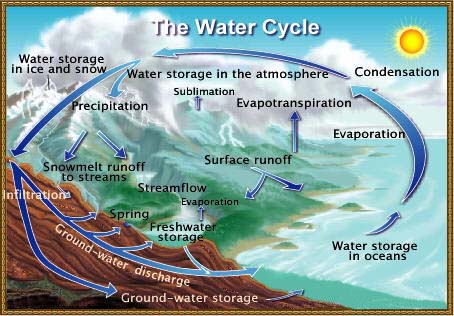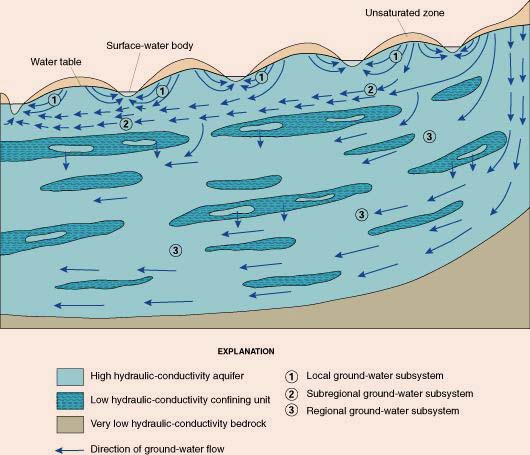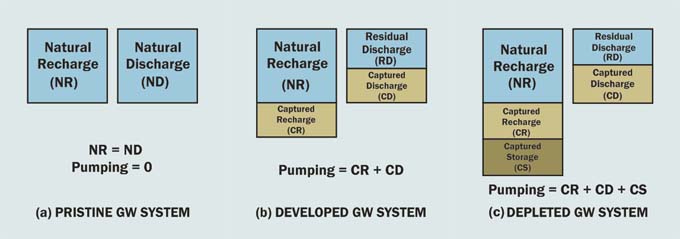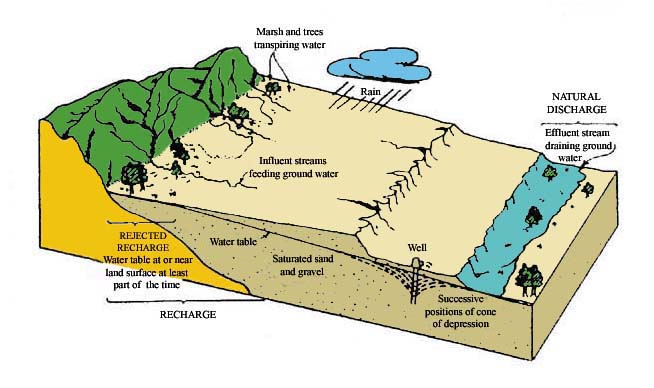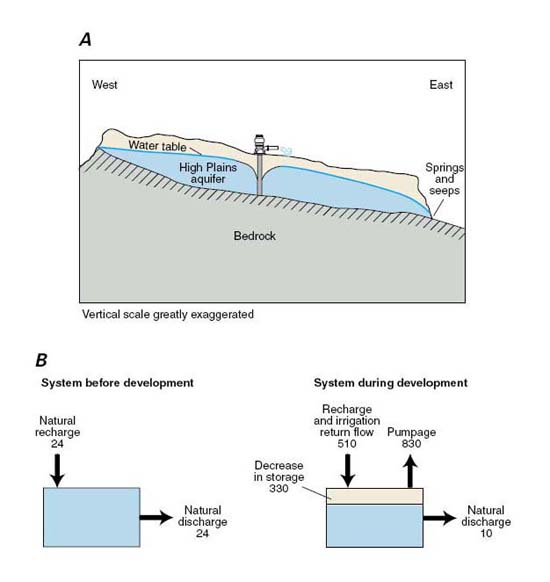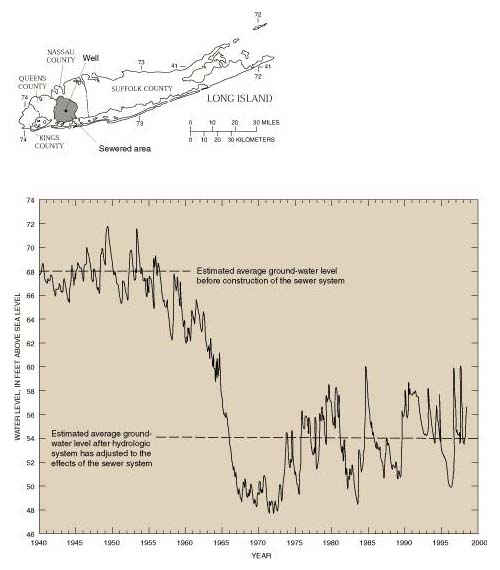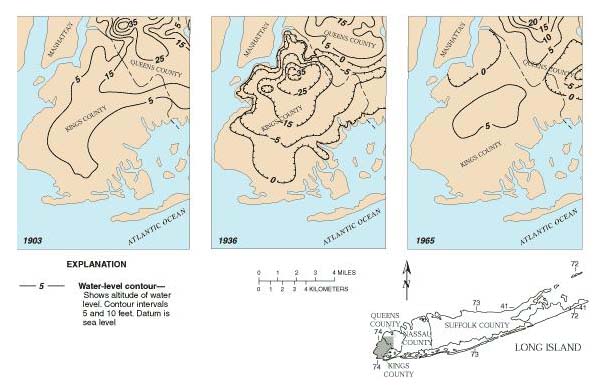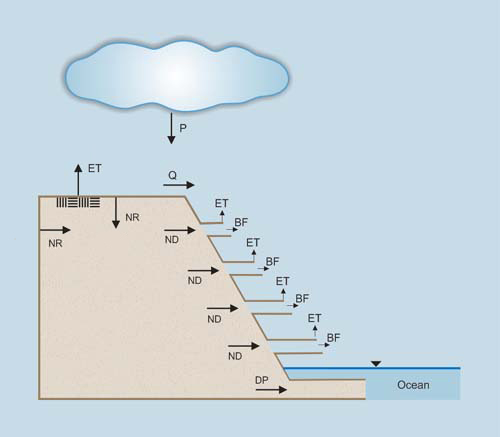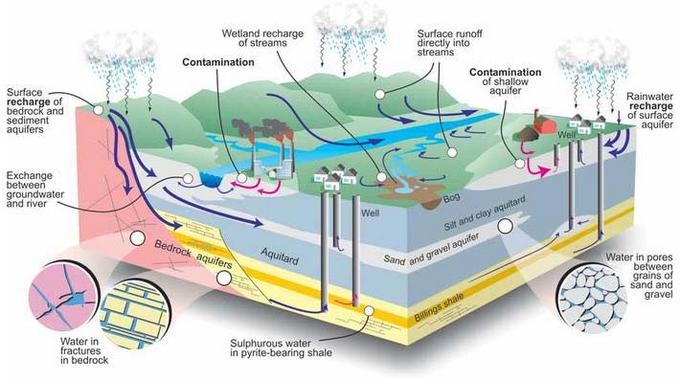|
|
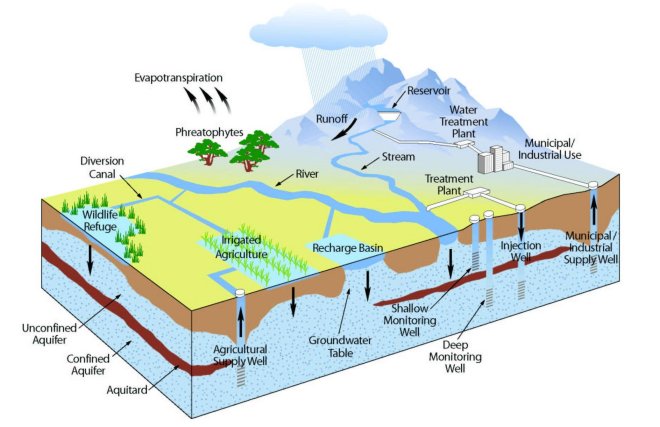
|
| California Department of Water Resources |
|
SUSTAINABLE YIELD OF GROUNDWATER
Victor M. Ponce
May 2007
1. INTRODUCTION
Water occurs both on the surface and under the surface of the Earth. The water on the surface is called "surface water" and the water under the surface is called "ground water" (Fig. 1). They are both part of the hydrologic cycle, which is the continuous recirculatory movement of the waters of the Earth (Fig. 2). In nature, surface water and ground water are related. Surface water can become ground water through infiltration, while ground water can become surface water through exfiltration. Therefore, surface water and ground water are inextricably connected; one cannot be considered or evaluated without regard to the other. While being part of the hydrologic cycle, the similarities between surface water and ground water appear to end there. They can be shown to differ in two important ways:
With development pressures taxing the surface waters in many regions of the world, the trend has been to use ground water to help resolve perceived surface water scarcities. Without regulation, this trend places communities on a sure path toward groundwater mining. Thus, the question of sustainability has arisen: To what extent can groundwater resources be exploited without compromising the principle of sustainable development? This study examines the historical development of groundwater use and of the limits placed thereon throughout the years. The concepts of safe yield and sustainable yield are reviewed. The traditional concept of safe yield, which equates safe yield to annual recharge, is shown to be flawed because of its narrow focus. Sustainable yield extends beyond the conventional boundaries of hydrogeology, to encompass surface water hydrology, ecology, and other related topics. The study concludes with a holistic approach to the sustainable yield of ground water. 2. BACKGROUND
Excessive groundwater pumping can lead to groundwater depletion, and this may have serious social and economic consequences. Attempts to limit groundwater pumping have been commonly based on the concept of safe yield, defined as the attainment and maintenance of a long term balance between the annual amount of ground water withdrawn by pumping and the annual amount of recharge. This definition is too narrow because it does not take into account the rights of groundwater-fed surface water (springs and baseflow) and groundwater-dependent ecosystems (wetlands and riparian vegetation) (Sophocleous, 1997).
Recently, the emphasis has shifted to sustainable yield (Alley and Leake, 2004; Maimone, 2004; Seward et al., 2006). Sustainable yield reserves a fraction of safe yield for the benefit of the surface waters. There is currently a lack of consensus as to what percentage of safe yield should constitute sustainable yield. The issue is complicated by the fact that knowledge of several related earth sciences is required for a correct assessment of sustainable yield. Additionally, there are social, economic, and legal implications which have a definite bearing on the analysis. At the outset, a distinction is necessary between pristine and non-pristine groundwater reservoirs. Pristine reservoirs are those that have not been subject to human intervention; conversely, non-pristine reservoirs have a history of pumping. Average annual recharge is normally taken over the period of record or some other suitably long period. Actual values of annual recharge may differ from the long-term average value. In pristine reservoirs, average natural recharge, which is a fraction of precipitation, is equal to average natural discharge, which feeds springs, streams, wetlands, lakes, and groundwater-dependent ecosystems. Thus, net recharge, i.e, average annual recharge minus average annual discharge, is zero (Theis, 1940). Natural discharge constitutes the baseflow of streams and rivers, and, in shallow groundwater reservoirs, it is the water that sustains certain types of vegetation, such as the hydrophytes, hygrophytes, and phreatophytes (see Glossary). Most groundwater is continuously flowing, subject to gravitational forces, eventually to join the surface waters (Fig. 3), or, ultimately, the ocean (see also Fig. 10). It is only a matter of time before the natural recharge shows up as natural discharge, i.e., as evapotranspiration or surface water, somewhere downstream.
Three groundwater scenarios are possible:
A pristine groundwater system, in equilibrium or steady state, in the absence of pumping;
A developed groundwater system, in equilibrium or steady state, with moderate pumping at a fixed depth;
and
A depleted groundwater system, in nonequilibrium or unsteady state, with heavy pumping at an ever increasing depth.
In the pristine groundwater system (Fig. 4 a), [average] natural recharge is equal to [average] natural discharge, net recharge is zero, and pumping is zero.
Thus, natural recharge (the blue block on the left) equals natural discharge (the blue block on the right) (Fig. 4 a).
In the developed groundwater system (Fig. 4 b), captured recharge (the brown block on the left) is the increase in recharge induced by pumping.
Likewise, captured discharge (the brown block on the right) is the decrease in discharge induced by pumping.
Then, residual discharge (the blue block on the right) is equal to natural recharge (the blue block on the left) minus captured discharge.
Net recharge is equal to the sum of captured recharge plus captured discharge.
Net recharge varies with the intensity of pumping;
the greater the intensity of pumping, the greater the net recharge.
Pumping in the developed groundwater system is equal to net recharge, i.e., capture (Fig. 4 b).
In addition to captured recharge and captured discharge, the depleted groundwater system (Fig. 4 c) also features captured storage (the dark brown block on the left).
Net recharge is equal to captured recharge plus captured discharge.
Pumping in the depleted groundwater system is equal to net recharge plus captured storage (Fig. 4 c).
The greater the level of development,
the greater the amounts of captured recharge and captured discharge, and, in the case of a depleted system, captured storage. The greater the captured discharge, the smaller the residual discharge.
Since all aquifer discharge feeds surface water and evapotranspiration, it follows that
intensive groundwater development can substantially affect local, subregional, or regional groundwater-fed surface water bodies and groundwater-dependent ecosystems.
Fig. 4 Recharge and discharge in groundwater systems: 3. PERSPECTIVE
Lee (1915) defined safe yield as the limit to the quantity of water which can be withdrawn regularly and permanently without dangerous depletion of the storage reserve. He noted that water permanently extracted from an underground reservoir reduces by an equal quantity the volume of water passing from the basin by way of natural channels, i.e., the natural discharge. To illustrate the existence of this natural discharge, Lee observed that heavy pumping would commonly result in the drying up of springs and wetlands. Thus, he distinguished between a theoretical safe yield, equal to the natural recharge, and a practical safe yield, a lower value which takes into account the need to maintain a residual discharge (Fig. 4 b). According to Lee, the residual discharge must be ascertained and deducted from the theoretical safe yield in order to obtain the practical safe yield. Theis (1940) recognized that all ground water of economic importance is in constant movement through a porous rock stratum, from a place of recharge to a place of discharge (Fig. 5). He reasoned that under pristine conditions, aquifers are in a state of approximate dynamic equilibrium. Discharge by pumping is a new discharge superimposed on a previously stable system; consequently, it must be balanced by:
Significantly, Theis (1940) distinguished between natural recharge and available recharge. Available recharge is the sum of unrejected and rejected recharge (Fig. 5). The unrejected recharge is the natural recharge; the rejected recharge is the portion of available recharge rejected by [portions of] an aquifer on account of being full (at least part of the time). To assure maximum utilization of the supply, Theis argued that groundwater development should tap primarily the rejected recharge and, secondarily, the evapotranspiration by non-productive vegetation. Thus, he defined perennial safe yield as equal to the amount of rejected recharge plus the fraction of natural discharge that it is feasible to utilize. According to Theis (1940), where rejected recharge is zero, the only way to replace the well discharge is by artificial recharge. The latter is the increase in recharge induced by human design.
Fig. 5 Factors controlling the response of an aquifer to discharge Kazmann (1956) argued that the concept of safe yield, when taken independent of considerations of regional hydrology, is a fallacious one, because it cannot be reconciled with the legal doctrine of appropriation. All water coming from the ground must be replaced by water coming from the land surface in order for a perennial groundwater supply to be obtained. When all surface runoff in the area overlying an aquifer has been appropriated, a perennial supply cannot be obtained from the ground without encroaching on established rights. Echoing Theis (1940), Kazmann saw artificial recharge as an effective technological fix to the safe yield quandary.
Artificial recharge is useful where water is being lost by runoff in the same areas where ground water supplies are being depleted.
The need for recharge is apparent when springs start to dry up, pumping lifts increase, or shallow wells go dry.
If these conditions persist for a reasonably long time, the ground water is probably being mined.
In artificial recharge, the excess runoff is retained in locations where there are possibilities for increased underground storage.
The usual methods employed are the improvement of natural openings and the impoundment of storm runoff for slower release.
Todd (1959) defined safe yield as the maximum quantity of water which can be extracted from an underground reservoir, yet still maintain the supply unimpaired. Pumping in excess of safe yield leads to overdraft, which is a serious problem in certain groundwater basins in the United States and elsewhere. He argued that until overdrafts are reduced to safe yields, permanent damage or depletion of the ground water supplies is to be expected. He referred to permanent depletion as mining of groundwater because of its analogy to the mining of ores and petroleum. The concept of sustainable development emerged in the late 1980s, forcing a reconsideration of safe yield practices. Sustainable development must meet the needs of the present without compromising the ability of future generations to meet their own needs (World Commission on Environment and Development, 1987). Implicit within this definition is the realization that natural resources could be exploited in an unsustainable fashion, i.e., in a way that future generations will find it increasingly difficult to avail themselves of similar quantities of the same resources. Thus, the intergenerational ethical dilemma. Sustainability refers to renewable natural resources; therefore, sustainability implies renewability. Since groundwater is neither completely renewable nor completely nonrenewable, it begs the question of how much groundwater pumping is sustainable. In principle, sustainable yield is that which is in agreement with sustainable development. This definition is clear; however, its practical application requires the understanding of complex interdisciplinary relationships, which have only recently been examined. Alley et al. (1999) defined groundwater sustainability as the development and use of ground water in a manner that can be maintained for an indefinite time without causing unacceptable environmental, economic, or social consequences. The definition of "unacceptable" is largely subjective, depending on the individual situation. For instance, what may be established as an acceptable rate of groundwater withdrawal with respect to changes in groundwater level, may reduce the availability of surface water, locally or regionally, to an unacceptable level. According to Alley et al. (1999), the term safe yield should be used with respect to specific effects of pumping, such as water level declines or reduced streamflow. Thus, safe yield is the maximum pumpage for which the consequences are considered acceptable. Alley et al. (1999) focused on the High Plains aquifer as a field example of how groundwater systems change in response to pumping and its relation to sustainability. The southern part of the High Plains aquifer [in New Mexico and Texas] slopes gently from west to east, and it is cut-off from external sources of water upstream and downstream by river-carved escarpments (Fig. 6 A). Before development, discharge along the eastern escarpment equaled recharge (Fig. 6 B, left). During development, recharge increased from 24 to 510 million cubic feet per day, discharge decreased from 24 to 10 million cubic feet per day, and storage decreased 330 million cubic feet per day (Fig. 6 B, right). The southern High Plains aquifer is perhaps the best known example of significant long term nonequilibrium (overdraft) of a regional groundwater system in the United States.
High Plains aquifer (Alley et al., 1999). Sophocleous (2000a) pointed out that the traditional concept of safe yield ignores the fact that, over the long term, natural recharge is balanced by discharge from the aquifers by evapotranspiration and/or exfiltration into streams, springs, and seeps. Consequently, if pumping equals recharge, eventually streams, marshes, and springs may dry up. Additionally, continued pumping in excess of recharge may eventually deplete the aquifer. To illustrate, Sophocleous presented two maps of perennial streams in Kansas, within the High Plains aquifer (Fig. 7). The latter map (1994) shows a marked decrease in total length of streamflows in the western third of the state, within the elapsed period (1961-1994), showing the impact of groundwater depletion on surface-water resources.
(Sophocleous, 2000). Loucks (2000) observed that the assessment of sustainability must involve professionals from other disciplines. Sustainability studies will require a balance of the entire hydrologic system, not just of the aquifer. A careful accounting of the fate of all water is essential for effective management. Aboveground consumption is the key to sustainable management, and not necessarily the rate at which groundwater is pumped (Kendy, 2003). Alley and Leake (2004) recognized the dependence of yield on the amount of capture. Unlike natural recharge, which tends to be a constant for a given basin, capture is a function of the level of development; the greater the pumping, the greater the capture. Thus, capture could not be sustainable in all cases. There is concern about the long-term effects of groundwater development on the health of springs, wetlands, lakes, streams, and estuaries. Sustainability is seen as all-encompassing, addressing issues across the disciplines. Maimone (2004) argued that if sustainable yield must be all-inclusive, the idea that there exists a single, correct number representing sustainable yield must be repealed. Instead, he proposed a working definition, coupled with an adaptive management approach, based on the following components:
Seward et al. (2006) found serious problems with the simplistic assumption that sustainable yield should equal recharge. In many cases, sustainable yield will be considerably less than average annual recharge; therefore, the general statement that sustainable or "safe" yield equals recharge is incorrect. Natural recharge does not determine sustainable yield; rather, the latter is determined by the amount of capture that it is permissible to abstract without causing undesirable or unacceptable consequences. 4. ANALYSIS
The historical perspective confirms that safe yield and sustainable yield are indeed evolving concepts. Lee (1915) was the first to recognize the need to reserve a fraction of the recharge for the benefit of the surface waters and related ecosystems. Theis (1940) thought it advisable to rely primarily on the rejected recharge, if any, to guarantee a portion of the safe yield. Kazmann (1956) believed that, since all recharge was already part of the surface waters, an effective way of assuring a sustained supply of groundwater was to rely on artificial recharge. Alley et al. (1999) and Seward et al. (2006) focused instead on whether the effects of groundwater pumping were socially acceptable. Thus, in assessing groundwater sustainability, issues of surface water hydrology, ecology, and water resources technology are seen to be intertwined with the issue of social license. The concepts may be summarized as follows:
The solution is to focus on a water balance that considers both surface water and ground water. Precipitation, the source of all ground water, separates into several components (paths) as follows:
Of the five components of precipitation, only the third (direct runoff) is totally independent of ground water. Fractions of evaporation and evapotranspiration may [originate and] be part of ground water. All baseflow originates and is part of ground water. All deep percolation is part of ground water, but not part of streamflow.
The components vary with climate, scale, and local/regional geologic/hydrogeologic conditions.
Fig. 8 Global components of precipitation. Like precipitation, natural recharge separates into several components (paths) as follows:
Of the five components of natural recharge, only No. 5 (deep percolation) is totally independent of the surface waters; therefore,
it may be a potential candidate for capture by groundwater systems.
Of the remaining four components (Nos. 1 to 4), it may be readily argued that all or fractions of No. 1 (evaporation from bare soil)
may be also a candidate for capture by groundwater systems.
It is more difficult to argue in favor of capturing all or fractions of No. 2 (evaporation from water bodies) and In general, a detailed water balance and related interdisciplinary studies are required to determine whether it is socially acceptable to set values of sustainable yield to encompass not only fractions of component No. 5 (deep percolation), but also appropriate fractions of components 1, 2, 3, and 4. Essentially, the goal is to be able to determine an appropriate yield-to-recharge percentage, and that this percentage be accepted as a reasonable compromise between conflicting interests. What are typical values of the yield-to-recharge percentage? In this connection, it is instructive to examine examples of usage-to-recharge percentages. Solley et al. (1998) have estimated that the pumpage of fresh ground water in the United States in 1995 was approximately 77 billion gallons per day, which is 8.6% of the estimated more than 891 billion gallons per day of natural recharge to the Nation's groundwater systems (Nace, 1960; Alley et al., 1999). Limited experience suggests that workable yield-to-recharge percentages are likely to be somewhat higher (Miles and Chambet, 1995; Prudic and Herman, 1996; Hahn et al., 1997). 5. CASES
This section describes several case studies of groundwater utilization. The objective is to provide a practical view of evolving issues in groundwater management.
Recent experience in Nevada suggests that groundwater modeling can be effectively used for a long term assessment of the water balance (Prudic and Herman, 1996).
Paradise valley is within the watershed of the Humboldt river, in Humboldt County, Nevada. According to a calibrated pre-development steady-state groundwater model,
natural inflow to, and outflow from, the Paradise valley groundwater system was 91 hm3yr-1.
Approximately 88% of the inflow (recharge) occurred through leakage from streams; the rest occurred though leakage along mountain fronts
and other secondary inflows.
About 96% of the discharge occurred through evapotranspiration; the rest ocurred through leakage to streams and other outflows.
A simulation of 300 years of pumping was performed, using the magnitude and distribution of pumping of 1982, followed by 300 years with no pumping.
The results of the simulation show the long-term consequences of groundwater withdrawals. Initially the pumped water came mostly from storage; with time, however, storage changes diminished, and increasingly the source of water came from a reduction in evapotranspiration and a decrease in streamflow. After 300 years, 72% of the pumped water was coming from reductions in evapotranspiration, 24% from reductions in streamflow, and only 4% from aquifer storage (Prudic and Herman, 1996). This study shows that under long-term equilibrium conditions, groundwater capture is likely to come, first, from reductions in evapotranspiration, and second, from reductions in streamflow. Miles and Chambet (1995) assumed that there is an acceptable level to which outflows from an aquifer (baseflow) may be allowed to fall, following groundwater pumping. The acceptable level of baseflow reduction is then linked to the expected drought duration and used to calculate a yield-to-recharge ratio. The latter is expressed as a function of dimensionless aquifer diffusivity, with the level of baseflow reduction as a curve parameter. [The dimensionless aquifer diffusivity is: ν = (tT)/(L2S), in which t = time, T = transmissivity, S = coefficient of storage, and L = aquifer length]. The method was applied to the catchment of the River Worfe, in Wales, Great Britain, and its underlying Bunter Sandstone aquifer. Calculated yield-to-recharge percentages, when baseflow was reduced to zero, which is clearly the least conservative assumption, varied in the range 50-78%.
In Cheju Island, Korea, the mean annual precipitation is 1872 mm, which amounts to 3.39 km3 yr-1.
Sophocleous (2000a, 2000b) has provided extensive documentation on the Kansas experience in groundwater management. In 1972, the Kansas Legislature passed the Kansas Groundwater Act authorizing the formation of local groundwater management districts (GMDs) to help control and direct the development and use of groundwater resources. In the mid 1970s, the Central Kansas GMDs 2 and 5 adopted a safe yield policy of balancing groundwater pumping with the average annual recharge (Fig. 9). This policy slowed down the rate of groundwater depletion, but it did not stop it. Following the establishment of the safe yield policy, both GMD 2 and GMD 5 experienced groundwater level declines of more than 6 m in parts of their districts. In some areas, the depletion amounted to 60 m, reducing by more that 50% the saturated aquifer thickness. As a result of these declines, streamflows in Western and Central Kansas have been decreasing and riparian vegetation has been progressively degrading, with numerous dead cottonwood and poplar trees visible around the countryside. In response to these streamflow declines, in 1984 the Kansas Legislature passed the minimum instream flow law, which requires that minimum desirable streamflows (MDS) be maintained in different streams in Kansas (Sophocleous, 2000a).
With continuing declines in groundwater levels and streamflow during the 1980s,
the Kansas
Alley et al. (1999) and Maimone (2004) have described the case of Nassau County, New York, as a tradeoff between groundwater quality and surface-water quantity.
Nassau County has an area of about 500 km2 and a population of 1.3 million people, and is a moderately densely populated
suburban county.
In the 1970s and 1980s, with nitrate concentrations in ground water increasing due to on-lot septic systems,
a decision was made to install sewer lines in 90% of the county, with ocean outfalls used for treated sewage disposal.
New York.
In Suffolk County, New York, with an area somewhat greater than 2000 km2 and a population slightly greater than Nassau County,
sewering accounts for less than 70 hm3yr-1 of consumptive use.
The Chester County Water Resource Authority, in Pennsylvania, has recently developed a comprehensive water resources plan for its watersheds (Chester County Water Resources Authority, 2002). Significantly, stream baseflow was selected as the standard against which to measure groundwater pumping. Accordingly, to protect stream baseflow, the regulation limited ground water withdrawals in the following categories:
The more conservative lower management target of 50%, applicable to first order streams and certain designated baseflow-sensitive subbasins, would protect half of the baseflow [low flow] that recurs instantaneously once every 25 years. [In practice, this means using up to 50% of the 1-day 25-year low flow]. The less conservative upper target of 100%, applicable to all other areas, would use up all the baseflow that recurs once every 25 years. In Kings County, New York, total groundwater withdrawals in 1903 were about 30 million gallons per day, with no obvious cone of depression observed at that time (Fig. 11). Total pumpage peaked in the 1920s to early 1940s at a maximum pumping rate of about 75 million gallons per day. In 1936, water table levels were near or below sea level throughout Kings County, and the cone of depression extended into southwestern Queens County. In 1947, public-supply pumpage ceased in Kings County. The source of water for public supply changed to the upstate surface-water system that supplies New York City through water tunnels. Furthermore, legislation was implemented during this period that required wastewater from some industrial/commercial uses, including air-conditioning water, to be recharged to the aquifer system. In this case, the focus was on recovering the depleted water tables rather than on preserving the quality of the ground water. Concurrently, and partly as a result of these changes, industrial pumping declined to a long term stable rate of slightly less than 10 million gallons per day. In 1965, heads have risen throughout Kings County (Fig. 11). Subsequent maps show a small but continuing recovery of the water table (Alley et al., 1999).
in Kings County, New York.
The cases described above enable the following conclusions:
Developed or depleted groundwater systems invariably lead to the degradation of riparian and wetland ecosystems.
Continued development or depletion of ground water leads to substantial reductions in baseflow.
Over the long term, capture in developed groundwater systems must come mostly from reductions in natural discharge.
Many communities are choosing to regulate groundwater use in order to protect riparian ecosystems, wetlands, and baseflow.
A decrease in groundwater pumping can recover depleted water tables and foster the return to more natural conditions.
Sustainable yield is unrelated to the size or hydrogeologic parameters of the aquifer.
Sustainable yield can no longer be equated with natural recharge.
Sustainable yield estimates are commonly based on a percentage of natural recharge, even though there appears to be no relation between them.
Lower percentages will be more conservative, while higher percentages will be less conservative.
Sustainable yield estimates span several disciplines,
from hydrogeology, to hydrology, ecology, economics, water resources technology, and the legal aspects of groundwater utilization.
Baseflow conservation is emerging as the standard against which to measure groundwater pumping and sustainable yield.
Sustainable yield is, for all practical purposes, a moving target; no single approach is applicable at all times and in all cases.
Enlightened sustainable yield assessments require an adaptive management approach.
6. SYNTHESIS
All groundwater reservoirs of economic importance are temporarily holding water in transit from a place of recharge to a place of discharge (Theis, 1940). Any amount of water extracted from the ground by mechanical means (through pumping) would have to be eventually replaced by the same amount coming from the surface waters. A pristine groundwater reservoir is in steady state, with inflows equal to ouflows. When a groundwater reservoir is full, it rejects all water, which has no choice but to augment the surface waters. Conversely, when a groundwater reservoir is not full, it can take more water, but it will discharge more water too, through natural discharge. The natural discharge supports riparian, wetland, and other groundwater-dependent ecosystems, as well as the baseflow of streams and rivers. All pumping comes from capture, and all capture is due to pumping (Seward et al., 2006). The greater the intensity of pumping, the greater the capture. Capture comes from decreases in natural discharge and increases in recharge, the latter coming either from increased ground surface recharge or from the surrounding areas. In depletion cases, capture is augmented with decreased storage, i.e., with a permanent lowering of the water table. The water that seeps below the ground surface can follow one of three paths:
Of these three, only deep percolation is completely independent of the surface waters. Therefore, it is the only component of precipitation (or recharge) that may be potentially subject to sequestering (capture) by pumping. Studies are needed on a local, subregional, and regional basis to determine deep percolation as a percentage of precipitation, or alternatively, as a percentage of recharge. For groundwater basins in close proximity to the ocean, the possibility of salt-water intrusion must be examined carefully. A groundwater reservoir is essentially a leaky, porous natural geologic container (Fig. 12). In nature, precipitation P separates into direct runoff Q, evaporation and evapotranspiration ET, and natural recharge NR. All natural recharge eventually flows out as either natural discharge ND or deep percolation DP, at various spatial scales, from small to large watersheds. Natural discharge can return to the atmosphere via evaporation and evapotranspiration ET, or to the ocean via baseflow BF. The deeper the ground water, the larger the spatial scale of natural discharge, from the local to the regional scale (Fig. 3).
Fig. 12 Geometric model of a groundwater reservoir. The portion of natural discharge that returns to the atmosphere via evaporation and evapotranspiration is mostly already committed. Only a small fraction of it (the water that evaporates directly from the ground) may be subject to capture, if deemed necessary to satisfy socioeconomic needs. The case for the sequestration of the other two fractions (the evaporation from bodies of water and the evapotranspiration from vegetation) is usually less defensible. Not all water pumped is lost to the groundwater system; only the water consumed and not returned to the aquifer. Thus, a precise water balance, which takes into account all uses, is needed to assess sustainability (Kendy, 2003). Sustainable yield does not depend on the size, depth, or hydrogeologic characteristics of the aquifer. Current practice notwithstanding, sustainable yield does not depend on the aquifer's natural recharge, because the natural recharge has already been appropriated by the natural discharge (Sophocleous, 2000a). Sustainable yield depends on the amount of capture, and whether this amount is socially acceptable as a reasonable compromise between little or no use, on one extreme, and sequestration of all natural discharge, on the other extreme. Sustainable yield is seen to be a moving target, to be determined after a judicious study and appraisal of all issues regarding groundwater utilization. These include hydrogeology, hydrology, ecology, climatology, social and economic development, and the related institutional and legal aspects, to name the most relevant.
In practice, sustainable yield may be taken as a suitable percentage of precipitation.
A reasonably conservative estimate would take up to the deep percolation amount as sustainable yield, provided that
it does not lead to excessive salt-water intrusion.
On a global basis, deep percolation amounts to about 2% of precipitation. In the absence of basin-specific studies, this figure may be used as a
point-of-start on which to base sustainable yield assessments.
A fraction of evaporation and evapotranspiration (ET) is seen to be part of discharge (ND), which originates in recharge (NR)
Sustainable yield can also be expressed as a percentage of recharge.
Globally, if recharge can be assumed to be approximately 20% of precipitation,
then deep percolation would be about 10% of recharge. Thus, a reasonably conservative estimate of sustainable yield would be 10% of recharge.
Limited experience indicates that average values of this percentage may be around 40%,
while less conservative percentages may exceed 70% (Miles and Chambet, 1995; Hahn et al., 1997).
Communities are beginning to consider baseflow conservation as the standard against
which to measure groundwater pumping and, therefore, sustainable yield (Maimone, 2004).
A fundamental question remains: Who owns the groundwater? The answer is by no means straighforward. In theory, whoever owns the natural discharge owns the groundwater that feeds that natural discharge. This natural discharge can be shown to provide natural and socioeconomic services. Natural services are associated with the maintenance of terrestrial and aquatic ecosystems that rely on the natural discharge. These ecosystems may comprise, for example, wetlands, riparian species, and minimum instream flows to sustain fisheries and wildlife. Socioeconomic services are associated with water rights that may have been already appropriated to individual users or social entities. In practice, it does not appear viable, in all cases, to disallow groundwater use on account that the entire natural discharge may have been already appropriated.
Experience shows that reasonable compromises may be established on a case-by-case basis. Groundwater sustainability may be enhanced by increasing recharge in three ways:
The greater the amount of capture coming from rejected recharge, the more sustainability is assured (Theis, 1940). Likewise, the greater the clean artificial discharge, the more sustainability is assured (Kazmann, 1956). Limiting negative artificial recharge, to the extent possible, would go a long way toward assuring sustainability. 7. CONCLUSIONS
The issue of how much to pump in a sustainable context is shown to have no simple answer.
It is clear that sustainable yield can no longer be taken as equal to natural recharge. A suitable compromise may be to consider sustainable yield as a fraction of natural recharge, provided a thorough evaluation is made of the tradeoffs, including the hydrological and ecological impacts of groundwater development. Baseflow, more properly baseflow conservation, is emerging as the standard against which groundwater pumping will be increasingly measured in the future. In the absence of detailed holistic studies, a reference value of sustainable yield may be taken as all, or a suitable fraction of, the global average for deep percolation, estimated as 2% of precipitation. Detailed local and regional studies will determine whether this value may be increased on a case-by-case basis to reflect one or more of the following:
Sustainability goes hand-in-hand with conservation; the more conservative the proposed or adopted policy, the more sustainable it will be. Sustainable yield is seen to be a moving target, subject to adaptive management. 8. SUMMARY
ACKNOWLEDGEMENTS
This study was made possible with the support of the people of the communities of Boulevard and Campo, in East San Diego County, California. REFERENCES
Alley, W. M., T. E. Reilly, and. O. E. Franke. (1999). Sustainability of groundwater resources. U.S. Geological Survey Circular 1186, Denver, Colorado, 79 p. Alley, W. M., and S. A. Leake. (2004). The journey from safe yield to sustainability. Ground Water, Vol. 42, No.1, January-February, 12-16. Chester County Water Resources Authority. (2002). Watersheds: An integrated water resources plan for Chester County, Pennsylvania, and its watersheds. Adopted September 17, 2002, 240 p. Hahn, J., Y. Lee, N. Kim, C. Hahn, and S. Lee. (1997). The groundwater resources and sustainable yield of Cheju volcanic island, Korea. Environmental Geology, 33(1), December, 43-52. Hardin, G. (1968). The Tragedy of the Commons. Science, Vol. 162, 1143-1148. Kazmann, R. G. (1956). "Safe yield" in ground water development: Reality or illusion? Journal of the Irrigation and Drainage Division, American Society of Civil Engineers, Vol. 82, No. IR3, November, Paper 1103. Kendy, E. (2003). The false promise of sustainable pumping rates. Ground Water, Vol. 41, No.1, January-February, 2-4. Lee, C. H. (1915). The determination of safe yield of underground reservoirs of the closed-basin type. Transactions, American Society of Civil Engineers, Vol. LXXVIII, Paper No. 1315, 148-218. Loucks, D. P. (2000). Sustainable water resources management. Water International, Vol. 25, No. 1, 3-10. L'vovich, M. I. (1979). World water resources and their future. Translation of the original Russian edition (1974), American Geophysical Union, Washington, D.C. Maimone, M. (2004). Defining and managing sustainable yield. Ground Water, Vol. 42, No.6, November-December, 809-814. Miles, J. C., and P. D. Chambet. (1995). Safe yield of aquifers. Journal of Water Resources Planning and Management, American Society of Civil Engineers, Vol. 121, No. 1, January/February, Paper No. 5381, 1-8. Nace, R. L.. (1960). Water management, agriculture, and groundwater supplies. U.S. Geological Survey Circular 415, Denver, Colorado, 12 p. National Research Council. (1994). Ground water recharge using waters of impaired quality. National Academy Press, Washington, D.C. Ponce, V. M. (2006). Groundwater utilization and sustainability. http://groundwater.sdsu.edu Prudic, D. E., and M. E. Herman. (1996). Ground-water flow and simulated effects of development in Paradise Valley, a basin tributary to the Humboldt River, in Humboldt County, Nevada. U.S. Geological Survey Professional Paper 1409-F. Seward, P., Y. Xu, and L. Brendock. (2006). Sustainable groundwater use, the capture principle, and adaptive management. Water SA, Vol. 32, No. 4, October, 473-482. Soil Conservation Service. (1967). Ground-water recharge. Technical Release No. 36, U. S. Department of Agriculture, Soil Conservation Service, Engineering Division, Geology, Washington, D.C. Solley, W. B., R. R. Pierce, and H. A. Perlman. (1998). Estimated use of water in the United States in 1995. U.S. Geological Survey Circular 1200, Denver, Colorado, 71 p. Sophocleous, M. (1997). Managing water resources systems: Why "safe yield" is not sustainable. Ground Water, Vol. 35, No.4, July-August, 561. Sophocleous, M. (2000a). From safe yield to sustainable development of water resources - The Kansas experience. Journal of Hydrology, Volume 235, Issues 1-2, August, 27-43. Sophocleous, M. (2000b). The origin and evolution of safe-yield policies in the Kansas Groundwater Management Districts. Natural Resources Research, Vol. 9, No. 2, 99-110. Theis, C. V. (1940). The source of water derived from wells: Essential factors controlling the response of an aquifer to development. Civil Engineering, Vol 10, No. 5, May, 277-280. Todd, D. K. (1959). Ground Water Hydrology. John Wiley and Sons. World Commission on Environment and Development (The Brundtland Commission). (1987). Our Common Future. The United Nations, New York. World Water Balance and Water Resources of the Earth. (1978). U.S.S.R. Committee for the International Hydrological Decade, UNESCO, Paris, France. GLOSSARY
aquifer = a saturated permeable geologic formation which can yield significant quantities of water to wells and springs (Fig. 13). aquifer length [L] = the dimension of an aquifer in a direction perpendicular to the draining stream. aquitard = the less permeable beds in a stratigraphic sequence, not permeable enough to yield significant quantities of water to wells and springs (Fig. 13). artificial recharge = the increase in groundwater recharge induced by human design. available recharge = the sum of unrejected recharge and rejected recharge, if the latter is nonzero. baseflow = the fraction of streamflow that originates in ground water. baseflow conservation = the policy of protecting baseflow to minimize the risk of capture by ground water. bog = a type of wetland that accumulates acidic peat, a deposit of dead plant material (Fig. 13). capture = the amount withdrawn by pumping. captured discharge = the decrease in discharge induced by pumping. captured recharge = the increase in recharge induced by pumping. captured storage = the decrease in groundwater storage induced by non-equilibrium pumping. coefficient of storage [S] = the ratio of free-draining water volume to aquifer volume. confined aquifer = an aquifer whose upper boundary is below the water table (Fig. 1). conservation = a careful protection of something of intrinsic value, such as a finite natural resource. consumptive use = the amount of groundwater use that is consumed, therefore, not returned through aquifer recharge. deep percolation = the fraction of precipitation (or recharge) that returns directly into the ocean, bypassing the surface waters. depleted system = a groundwater system in non-equilibrium or unsteady state, with heavy pumping at ever increasing depths. developed system = a groundwater system in equilibrium or steady state, with moderate pumping at a fixed depth. dimensionless aquifer diffusivity = a dimensionless expression of aquifer diffusivity, based on the relation (tT)/(L2S), in which t = time, T= transmissivity, S = storage coefficient, and L = length. direct runoff = the runoff that flows directly on the surface, without infiltrating under the ground. ecosystem = a natural system consisting of a collection of biotic and abiotic components, including flora, fauna, lower life forms, water and soil, governed by a set of natural laws. evaporation = the process by which atoms or molecules in a liquid state gain sufficient energy to enter the gaseous state. evapotranspiration = the sum of evaporation and plant transpiration, which is the movement of water within plant and the subsequent loss of water as vapor through stomata in its leaves. exfiltration = the water that percolates into the ground surface from below. gravitational force = the force that drives all mass from a place of higher potential to a place of lower potential. ground water = the water flowing by gravity, below the surface of the Earth, and which fills the pore spaces of the alluvium, soil, or rock formation. groundwater mining = the depletion of a groundwater reservoir beyond its capacity to replenish naturally. holistic = concerned with the whole, rather than with the parts; seamless. hydraulic conductivity [K] = the [mean] velocity of flow through soil or rock formation [aquifer]. hydrologic cycle = the continuous recirculatory movement of the waters of the Earth. hydrophyte = a plant adapted to live in water or waterlogged soil. hygrophyte = a plant that thrives in very wet soil and/or is more or less restricted to moist sites. infiltration = the water that percolates downward, below the ground surface, through the upper soil layers. natural discharge = discharge to the surface waters [exfiltration], which feeds springs, streams and rivers, wetlands, lakes, and groundwater-dependent ecosystems. natural recharge = groundwater replenishment from runoff or snowmelt, through seepage from the surface. negative artificial recharge = the decrease in recharge induced by socioeconomic activities, such as deforestation. overgrazing, overcultivation, and urban development. net recharge = the difference between recharge and discharge. non-pristine reservoir = a reservoir that has a history of pumping. nonrenewable = not replenishable, or unrecoverable, within a period less than a human lifespan. phreatophyte = rooted plant that obtains water from a permanent ground supply or from the water table, or from soil just above it. primary treatment = the wastewater treatment level that removes settleable organic and inorganic solids by sedimentation, and floating materials by skimming. pristine reservoir = a reservoir that has not been subject to human intervention. recharge = any addition to the groundwater system by percolation through the land surface (Fig. 13). recharge basin = a reservoir or basin which has the purpose of recharging surface water into the ground water (Fig. 1). rejected recharge = the amount of available recharge rejected by an aquifer on account of being full (at least part of the time). residual discharge = the difference between natural discharge and captured discharge. renewable = replenishable or recoverable within a period less than a human lifespan. riparian vegetation = vegetation that satisfies its physiological needs for water by extracting it from the groundwater or the overlying unsaturated (vadose) zone. runoff = the water flowing on the surface of the Earth, from rain, snowmelt, and other sources. safe yield (traditional) = the attainment and maintenance of a long-term balance between the annual amount of groundwater withdrawn and the annual amount of recharge. secondary treatment = the wastewater treatment level that removes soluble and colloidal biodegradable organic matter and suspended solids and, in some cases, nitrogen and phosphorus. simulation = the imitation or modeling of a prototype or system, by describing its properties, using abstractions, and seeking answers to "what if" questions. spring = a natural feature (location) where concentrated groundwater flow exfiltrates into the land surface or surface water body. stream = natural feature whose purpose is to return a fraction of precipitated water, and the solids it carries, to the ocean, thus closing the hydrologic cycle. streamflow = the sum of direct runoff and baseflow. surface runoff = the runoff flowing on the surface of the Earth directly into streams (Fig. 13). surface water = the water flowing on the surface of the Earth, including overland flow and streamflow. sustainable development = the development that meets the needs of the present without compromising the ability of future generations to meet their own needs. sustainable yield = the groundwater yield which is in agreement with the principle of sustainable development. tertiary treatment = any physical, chemical, or biological treatment process used to accomplish a degree of wastewater treatment greater than that achieved by secondary treatment. traditional safe yield = the attainment and maintenance of a long-term balance between the annual amount of groundwater withdrawn and the annual amount of recharge. transmissivity [T] = the product of hydraulic conductivity K and aquifer thickness b, i.e., T = Kb; a measure of the volume of water that moves through an aquifer. unconfined aquifer = an aquifer whose upper boundary is the water table (Fig. 1). undeveloped reservoir = a reservoir that has not been subject to human intervention. unrejected recharge = the amount of available recharge taken by an aquifer on account of not being full. vadose zone = the unsaturated zone extending between the ground surface and the water table. water balance = an accounting of the various components of the hydrologic cycle. water table = the upper surface of the zone of saturation in an unconfined aquifer. water quality = the description of the chemical, physical, and biological characteristics of water, usually in regard to its suitability for a particular purpose or use. watershed = the land area from which water drains into a point, either a stream, river, or reservoir. wetland = a terrestrial ecosystem where the water table is regularly at or close to the ground surface.
|
